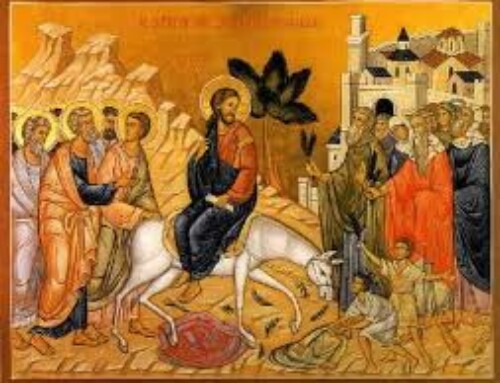Word Magazine February 1975 Page 11-12
THE ICONOCLASTIC CRISIS
By Rev. Fr. Gabriel Barrow
According to the Oxford Greek-English Lexicon, icon means a figure, image, or likeness.
It was icons (of Christ, the Theotokos, and the Saints), the most outstanding characteristic of the Eastern Orthodox temple of worship, that caused one of the major controversies of the Eastern Church: THE ICONOCLASTIC CRISIS.
During this crisis, the Church was divided into two groups: the Iconoclasts and the Orthodox. The Iconoclasts were against the use of icons and the Orthodox favored their use. Icons are basically a cultural type of phenomenon that were natural to the Greeks, who always had their idols, and alien to the Syrians, who were not used to idols. As the Church was most influenced by the Emperors, the Iconoclast Emperors Leo III, the Isaurian (717-741); Constantine V, Copronymos (741-775) ; and their successors dealt misery to the Orthodox. It was in the year 730 that Leo III issued his doctrine against the use of icons. We can see the controversy take the form of a Christological debate as a result of the 82nd Canon of the Quinisext Council, held in 692. The Canon stated:
“… henceforth Christ our God must be represented in his human form instead of the ancient lamb.”
Thus the negative attitude of the Quinisext Council toward symbolism, and its emphasis on the concrete and historical reality of the Incarnation as the authentic foundation of the art of
images, made it inevitable that the debate started by the iconoclastic decree of the Emperor
Leo III should immediately become a Christological debate for the problem was already posed within the framework of a theology of the Incarnation.
We can owe the victory of the icons to the theology of three men, St. John of Damascus, St. Theodore the Studite, and Patriarch Nicephorus of Constantinople. St. John of Damascus writes: “I represent God, the Invisible One, not as invisible, but insofar as he has become visible for us by participation in flesh and blood. If we made an image of the invisible God, we would certainly be in error, but we do nothing of the sort; for we are not in error if we make the image of the incarnate God, who appeared on earth in the flesh, and who, in His ineffable goodness, lived with human beings and assumed the nature, the thickness, the shape and the color of the flesh.” Thus icons of Christ, the Theotokos, and the Saints are permitted by the Church, while icons of God the Father are condemned, since He never took on a visible characteristic or shape. The Iconoclasts reverted to the severe condemnations of idolatry in the Old Testament as the basis for their argument. St. John of Damascus, who was followed by all later Orthodox Fathers, opposes to it the totally new situation of the relationship between Creator and creatures, God and men, Spirit and matter, which follows the reality of the Incarnation. Thus Christ could be represented in a material image because he had become real man. Then the Iconoclasts replied with the following:
“. . . if the image represents the humanity of Christ to the exclusion of His divinity, it implies a Nestorian Christology and separates in Christ, God from man; if on the contrary, the iconographer pretends to represent Christ in the individual fullness of his divinity and his humanity, he assumes that the divinity itself can be circumscribed, which is absurd, or else that it lives in a state of confusion with the humanity; in the latter case he falls into the heresy of Dioscorus, Eutyches, and Severus.” The Iconoclast Christology rests on Chalcedonian Apophaticism but seems to ignore completely the main assertion that Chalcedon had borrowed from the Tome of Leo: “each nature preserves its own manner of being” and “meets the other (nature) in the single hypostasis.” Their Christology seems to indicate that the deification of the humanity of Christ suppresses the reality of the properly human natural character.
After the Iconoclast Council of 754 the debate centers on two problems: that of the image and that of the prototype. The Iconoclasts in the argument about the image stated that every image must necessarily be identical with the divine Model: an “image of God,” fabricated or painted, is therefore essentially an idol, since it pretends to “be God.” On this point the Orthodox called on tradition to show that the concept of image could in no way be reduced to an identification with the Model. Only the Son and the Spirit are natural images,” consubstantial to the Father, their Model, although different through their hypostasis. For a precise Orthodox definition of the cult of images we turn to the writings of St. John of Damascus and, especially, those writings of St. Theodore the Studite. The image, essentially distinct from the original, is an object of relative veneration or honor, while worship is reserved for God alone and can in no way be addressed to images. The religious action is addressed to the prototype, and then becomes adoration. Thus the same action is veneration insofar as it concerns the image of Christ, the Theotokos, and the Saints, and adoration or worship insofar as it is addressed to God. Orthodoxy made accusations of idolatry against the Latin Church when Thomas Aquinas himself admitted a “relative adoration” of the images. Thus we should not make images of God. “If someone dares make an image of the immaterial and in corporal divinity, we repudiate him,” writes St. John of Damascus. The Logos Himself, before the Incarnation, could not be represented: He is the image of the Father, but that image cannot be materially reproduced. It is not only vain, but it is stupid, to limit spatially the unincarnate Word . . . “it is idolatry,” writes St. Theodore.
The Orthodox polemic against iconoclasm insisted first on the fullness of the human nature in Christ, thus largely recovering the Christological tradition of Antioch. Theodore the Studite’s conception is “Christ was certainly not a mere man, neither is it Orthodox to say that he assumed an individual among men, but the whole, the totality of the nature. It must be said, however, that this total nature was contemplated in an individual manner—for otherwise how could it have been seen—in a way that made it visible and describable . ., which allowed it to eat and drink…?”
St. Nicephorus also stressed the human reality of Jesus, his experience of tiredness, of hunger, of thirst, and of human ignorance.
The main argument of the Orthodox polemicists against iconoclasm was the position of the Tome of Leo and of the Council of Chalcedon on the permanence of the characteristics proper to each of the two natures in Christ: ‘The Inconceivable is conceived in the womb of a Virgin, the Unmeasurable becomes three cubits high; the Unqualifiable acquires a quality; the Undefinable stands up, sits down and lies down: He who is everywhere is put into a crib; He who is above time gradually reaches the age of twelve; He who is formless appears with the shape of a man and the Incorporeal enters into a body . . . , therefore the same is describable and indescribable.
It is the Iconoclasts’ implicit Monophysitism that gives the Orthodox the opportunity to prove that their tradition remains based on Chalcedon, and faithful to what was fundamentally true in Antiochian Christology: the human reality of the historical Jesus. St. Theodore the Studite, in particular, bases the whole of his theology of icons on the doctrine of the hypostatic union. For Theodore, the very hypostasis of Christ is describable, and it is represented on the image. The Byzantine tradition, representing Christ with the letters o wh — “He who is,” the translation of the tetragrammaton YHWH—inscribed in the cross-shaped halo around the face of Jesus, well indicates the intention to see in the image the very hypostasis of the Son of God, no doubt invisible in its divinity, but having become visible in the human nature it had assumed. To Theodore “all portrait is, in any case, the portrait of a hypostasis, and not of a nature, . . . the image and the similitude with the prototype can only refer to one hypostasis and not to two.”
Thus it is only the personalism of patristic theology that makes it possible to overcome the essential dilemma of the iconclastic controversy and provides a solid basis for the veneration of images in the Orthodox Church.
The image of Christ, venerated by the Christians, bears witness to the reality of the Eucharist. The image of Christ is the visible and necessary witness to the reality and humanity of Christ. In this sense the Christian artist can be compared to God. “The fact that God made man in His image and resemblance shows that iconography is a divine action.” The artist, like God in the beginning, in representing Christ makes an “image of God” by painting the deified humanity of Jesus, hypostatized in the Word Himself. “From the moment the divinity united itself to our nature, our nature was glorified like some life—giving and wholesome medicine, and received access to incorruptibility: this is why the death of the saints is celebrated, temples are built in their honor, and their images are painted and venerated. The essence of the image is not venerated, but the form of the prototype represented by the image, . . . for it is not matter which is the object of veneration.”
No better conclusion could be drawn than that of the Kontakion for the First Sunday of Great Lent, known as Orthodoxy Sunday, which commemorates the victory of Orthodoxy over the Iconoclasts. The Kontakion reads:
“No one could describe the Word of the Father; but when He took flesh from you, 0 Theotokos, He accepted to be described, and restored the fallen image to its former state by uniting it to divine beauty. We confess and proclaim our salvation in word and images.”



